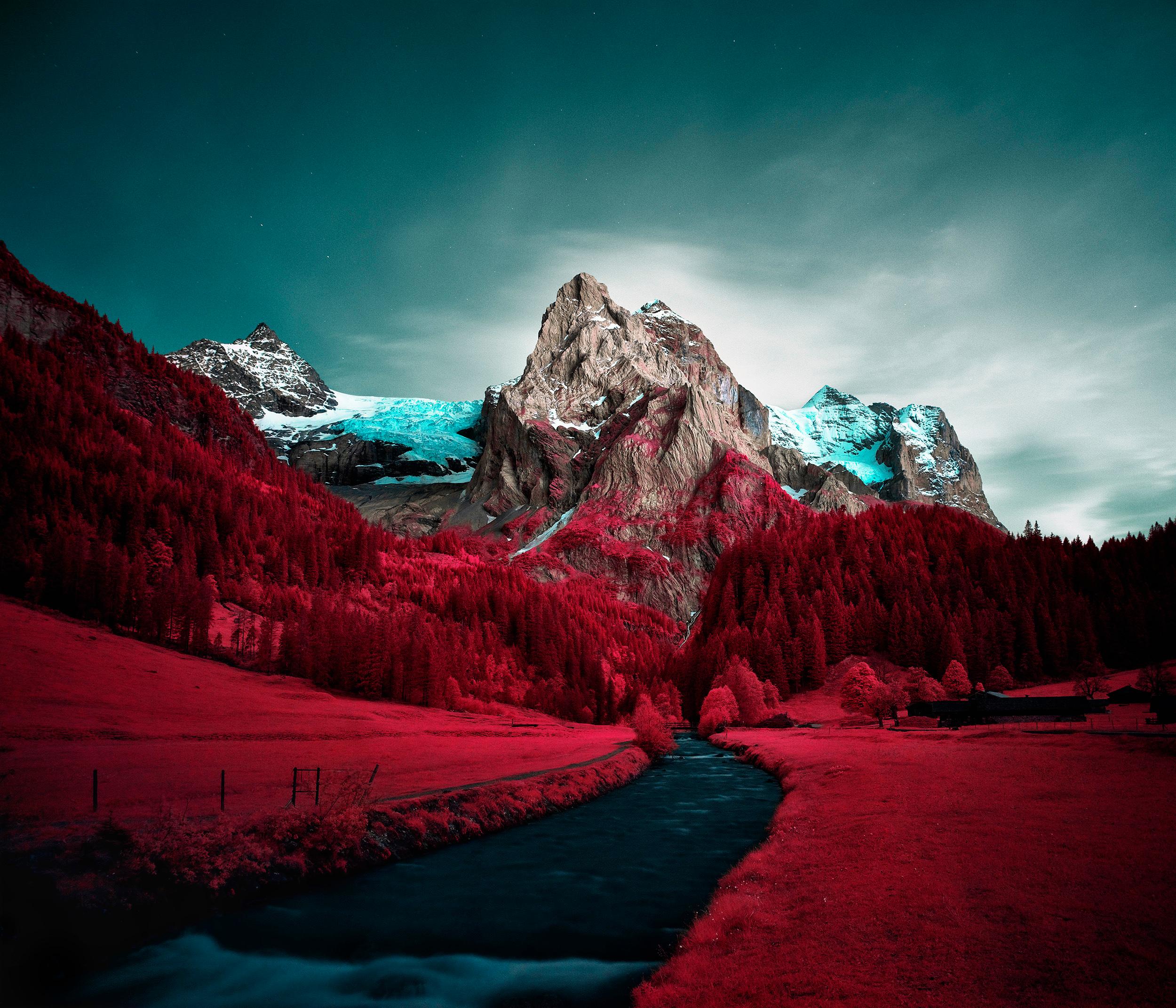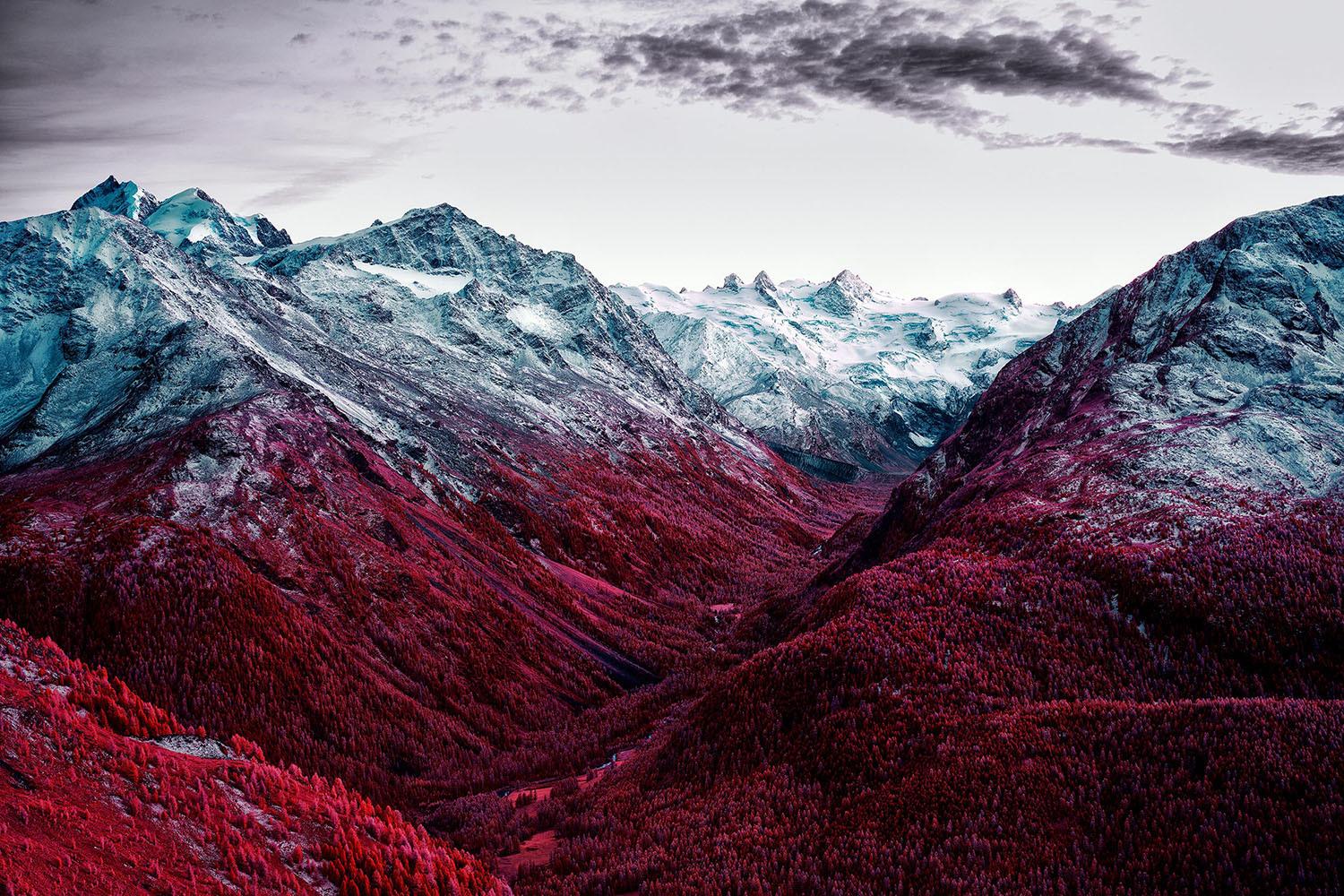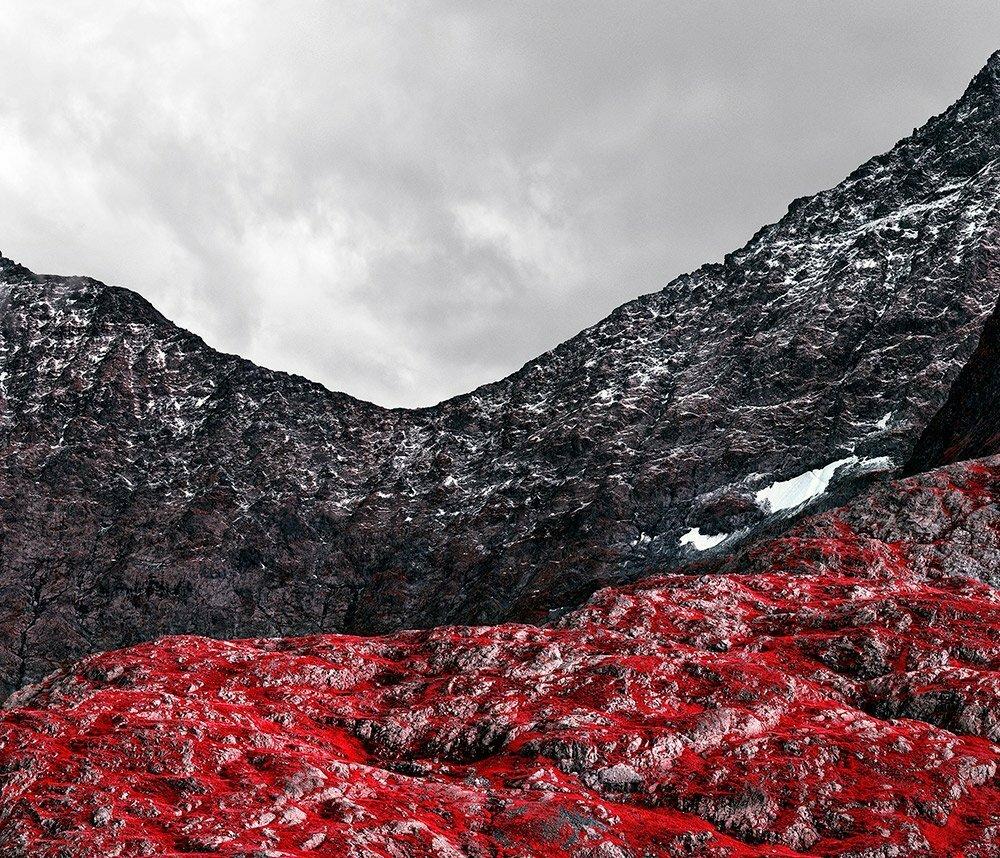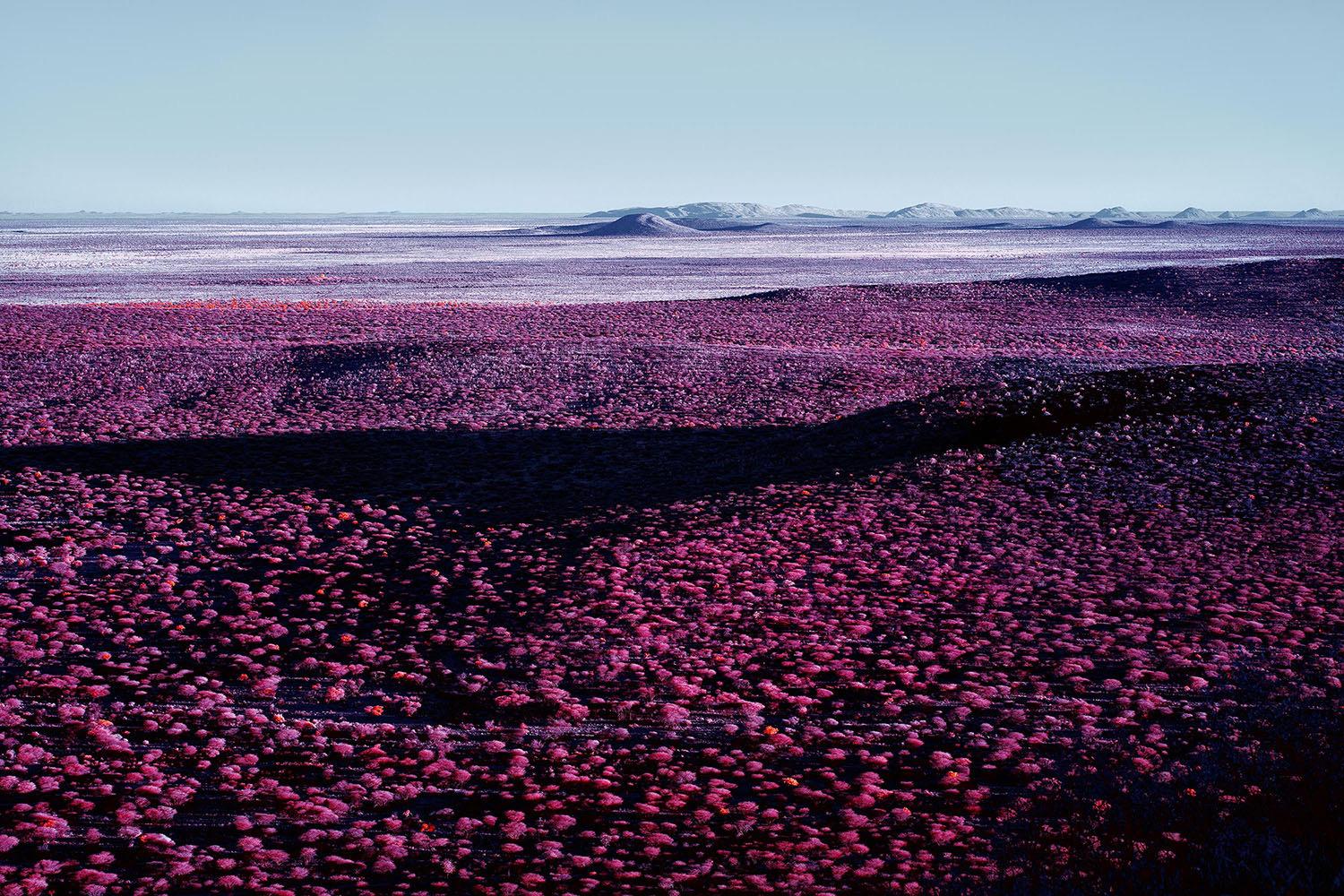Want more images or videos?
Request additional images or videos from the seller
1 of 5
Zak van BiljonFurka 1. Uri2021
2021
About the Item
Furka 1, Uri, 2021
Edition of 3
Pigment print on Canson photographic rag 310g, mounted on dibond in smoked oak wood frame with museum glass.
Framed: 53 x 53 x 3 cm
Other editions in 3 sizes, 3-2-1 + AP
To get a fresh look at natures beauty in a modern era, Zak van Biljon went beyond the visible spectrum to capture these vivid images.
The technique, developed for military surveillance and crop surveys, captures near-infrared light: wavelengths of electromagnetic radiation that fall between what we see as red and the longer wavelengths used for thermal imaging.
The pigment in plant leaves, chlorophyll, strongly absorbs visible light which they use as a source of energy in the process of photosynthesis.
The cell structure of the leaves, on the other hand, strongly reflects near-infrared light. A strong absorption at these wavelengths would only result in overheating the plant and possibly damaging the tissues. The human eye is unable to perceive infrared light but it is exactly this reflected energy, which reacts with infrared-sensitive material to create electric pinks and vibrant reds.
The idea of landscapes is not landscape by itself. Nothing exists by itself but only through perception. Our perception, however, is subject to both individual watching and classifying what we see.
The classification is strongly subdued to the imagery with which we are confronted every day. The famous Windows computer desktop image “Bliss” and others of this kind have become a kind of nature of which we believe that is is “true” nature.
Pictures of natures are not about falsifying nature itself but are reflecting our perception of nature. What kind of image do we have? On social media channels user are sharing zillions of filtered photos of nature – or what they think nature must look like.
- Creator:Zak van Biljon (1981, South African, Swiss)
- Creation Year:2021
- Dimensions:Height: 20.87 in (53 cm)Width: 20.87 in (53 cm)Depth: 1.19 in (3 cm)
- Medium:
- Movement & Style:
- Period:
- Condition:
- Gallery Location:Berlin, DE
- Reference Number:1stDibs: LU2647213202052
About the Seller
No Reviews Yet
Vetted Seller
These experienced sellers undergo a comprehensive evaluation by our team of in-house experts.
1stDibs seller since 2023
- ShippingRetrieving quote...Ships From: Berlin, Germany
- Return PolicyThis item cannot be returned.
More From This SellerView All
- Wetterhorn, BernLocated in Berlin, DEWetterhorn, Bern 2020 Edition on 2 Pigment print on Canson photographic rag 310g, mounted on dibond in smoked oak wood frame with museum glass. Framed: 68 x 76 x 3 cm Other edition in 3 sizes, 3-2-1 + AP To get a fresh look at natures beauty in a modern era, Zak van Biljon went beyond the visible spectrum to capture these vivid images. The technique, developed for military surveillance and crop surveys, captures near-infrared light: wavelengths of electromagnetic radiation that fall between what we see as red and the longer wavelengths used for thermal imaging. The pigment in plant leaves, chlorophyll, strongly absorbs visible light which they use as a source of energy in the process of photosynthesis. The cell structure of the leaves, on the other hand, strongly reflects near-infrared light. A strong absorption at these wavelengths would only result in overheating the plant and possibly damaging the tissues. The human eye is unable to perceive infrared light but it is exactly this reflected energy, which reacts with infrared-sensitive material to create electric pinks and vibrant reds. The idea of landscapes is not landscape by itself. Nothing exists by itself but only through perception. Our perception, however, is subject to both individual watching and classifying what we see. The classification is strongly subdued to the imagery with which we are confronted every day. The famous Windows computer desktop image “Bliss” and others of this kind have become a kind of nature of which we believe that is is “true” nature. Pictures of natures are not about falsifying nature itself but are reflecting our perception of nature. What kind of image do we have? On social media channels user are sharing zillions of filtered photos of nature...Category
2010s Naturalistic Landscape Photography
MaterialsRag Paper, Pigment
- SustenjochLocated in Berlin, DESustenjoch 2020 Edition of 2. Pigment print on Canson photographic rag 310g, mounted on dibond in smoked oak wood frame with museum glass. Framed: 68 x 76 x 3 cm Other Edition in 3 sizes, 3-2-1 + AP To get a fresh look at natures beauty in a modern era, Zak van Biljon went beyond the visible spectrum to capture these vivid images. The technique, developed for military surveillance and crop surveys, captures near-infrared light: wavelengths of electromagnetic radiation that fall between what we see as red and the longer wavelengths used for thermal imaging. The pigment in plant leaves, chlorophyll, strongly absorbs visible light which they use as a source of energy in the process of photosynthesis. The cell structure of the leaves, on the other hand, strongly reflects near-infrared light. A strong absorption at these wavelengths would only result in overheating the plant and possibly damaging the tissues. The human eye is unable to perceive infrared light but it is exactly this reflected energy, which reacts with infrared-sensitive material to create electric pinks and vibrant reds. The idea of landscapes is not landscape by itself. Nothing exists by itself but only through perception. Our perception, however, is subject to both individual watching and classifying what we see. The classification is strongly subdued to the imagery with which we are confronted every day. The famous Windows computer desktop image “Bliss” and others of this kind have become a kind of nature of which we believe that is “true” nature. Pictures of natures are not about falsifying nature itself but are reflecting our perception of nature. What kind of image do we have? On social media channels user are sharing zillions of filtered photos of...Category
2010s Naturalistic Landscape Photography
MaterialsPigment, Rag Paper
- Dammagletscher UriLocated in Berlin, DEDammagletscher Uri 2020 Edition 1, AP. Pigment print on Canson photographic rag 310g, mounted on dibond in smoked oak wood frame with museum glass. Framed: 144 x 128 x 7 cm. Other ...Category
2010s Naturalistic Landscape Photography
MaterialsRag Paper, Pigment
- Val Roseg, GrisonsLocated in Berlin, DEVal Roseg, Grisons 2019 Edition of 2. Pigment print on Canson photographic rag 310g, mounted on dibond in smoked oak wood frame with museum glass. Framed: 68 x 93 x 3 cm Editions in 3 sizes, 3-2-1 + AP To get a fresh look at natures beauty in a modern era, Zak van Biljon went beyond the visible spectrum to capture these vivid images. The technique, developed for military surveillance and crop surveys, captures near-infrared light: wavelengths of electromagnetic radiation that fall between what we see as red and the longer wavelengths used for thermal imaging. The pigment in plant leaves, chlorophyll, strongly absorbs visible light which they use as a source of energy in the process of photosynthesis. The cell structure of the leaves, on the other hand, strongly reflects near-infrared light. A strong absorption at these wavelengths would only result in overheating the plant and possibly damaging the tissues. The human eye is unable to perceive infrared light but it is exactly this reflected energy, which reacts with infrared-sensitive material to create electric pinks and vibrant reds. The idea of landscapes is not landscape by itself. Nothing exists by itself but only through perception. Our perception, however, is subject to both individual watching and classifying what we see. The classification is strongly subdued to the imagery with which we are confronted every day. The famous Windows computer desktop image “Bliss” and others of this kind have become a kind of nature of which we believe that it is “true” nature. Pictures of natures are not about falsifying nature itself but are reflecting our perception of nature. What kind of image do we have? On social media channels user are sharing zillions of filtered photos of nature...Category
2010s Naturalistic Landscape Photography
MaterialsColor, Alkyd, Rag Paper, Pigment
- RothkoLocated in Berlin, DERothko 2020 Edition 1, AP. Pigment print on Canson photographic rag 310g, mounted on dibond in grey oak wood frame with museum glass. Framed: 144.6 x 128 x 7 cm Other editions in 3 ...Category
2010s Naturalistic Landscape Photography
MaterialsRag Paper, Pigment
- Kalakwa 1, Khomas RegionLocated in Berlin, DEKalakwa 1, Khomas Region, 2018 Edition of 2 Pigment print on Canson photographic rag 310g, mounted on dibond in smoked oak wood frame with museum glass. Framed: 68 x 93 x 3 cm Other editions in 3 sizes, 3-2-1 + AP To get a fresh look at natures beauty in a modern era, Zak van Biljon went beyond the visible spectrum to capture these vivid images. The technique, developed for military surveillance and crop surveys, captures near-infrared light: wavelengths of electromagnetic radiation that fall between what we see as red and the longer wavelengths used for thermal imaging. The pigment in plant leaves, chlorophyll, strongly absorbs visible light which they use as a source of energy in the process of photosynthesis. The cell structure of the leaves, on the other hand, strongly reflects near-infrared light. A strong absorption at these wavelengths would only result in overheating the plant and possibly damaging the tissues. The human eye is unable to perceive infrared light but it is exactly this reflected energy, which reacts with infrared-sensitive material to create electric pinks and vibrant reds. The idea of landscapes is not landscape by itself. Nothing exists by itself but only through perception. Our perception, however, is subject to both individual watching and classifying what we see. The classification is strongly subdued to the imagery with which we are confronted every day. The famous Windows computer desktop image “Bliss” and others of this kind have become a kind of nature of which we believe that is is “true” nature. Pictures of natures are not about falsifying nature itself but are reflecting our perception of nature. What kind of image do we have? On social media channels user are sharing zillions of filtered photos of nature...Category
2010s Naturalistic Landscape Photography
MaterialsRag Paper, Pigment
You May Also Like
- Emergence IBy Jean- Michel LenoirLocated in New York, NYA resolutely minimalist and suggestive approach to get to the essential. Not trying to show a subject for what it is, but for what it expresses. This is my way of telling stories, of...Category
2010s Naturalistic Landscape Photography
MaterialsArchival Ink, Archival Paper, Photographic Paper, Archival Pigment
- The Blue CloudBy Jean- Michel LenoirLocated in New York, NYElevation 41 x 59" Ed. of 10, Framed Framed in a white wood shadow box. A resolutely minimalist and suggestive approach to get to the essential. Not trying to show a subject for wh...Category
2010s Naturalistic Landscape Photography
MaterialsArchival Ink, Archival Paper, Photographic Paper, Archival Pigment, Digi...
- Subtle ShadesBy Jean- Michel LenoirLocated in New York, NYElevation 41 x 59" Ed. of 10, Unframed We can frame it in a white wood shadow box. The frame price is 400$. A resolutely minimalist and suggestive approach to get to the essential. ...Category
2010s Naturalistic Landscape Photography
MaterialsPhotographic Paper, Archival Pigment, Archival Ink, Archival Paper
- Cobalt - a minimalist sea horizon landscape by french Photographer JM LenoirBy Jean- Michel LenoirLocated in New York, NYElevation 42 x 70" Ed. of 10, framed A resolutely minimalist and suggestive approach to get to the essential. Not trying to show a subject for what it is, but for what it expresses. This is my way of telling stories, of translating my sensibility”. J-M. Lenoir A passion for nature from an early age led Lenoir to photography as a means to capture magical moments of nature and wildlife. Starting with wildlife and wide spaces, he developed his own vision of photography. Landscape photography is an eternal quest for atmosphere where the light and the quest of beauty are key references, his aesthetic landmark. His photographic intention relies on his magnetic attraction for wide spaces combined with his quest of beautiful lights. A way that inspires him and his instinct of freedom. In photography, he is looking for simple pictures, which go straight to the subject core, with very few things in the frame. Lenoir follows a suggestive approach: he does not try to show a subject as it is, but to share what it expresses. It is his way of telling stories and conveying his sensibility, like his recent work “Evanescence”. Combining his passion for pictures with rugged landscapes, he organizes and guides photo tours with Photographes du Monde agency for seven years. From north of Europe (Scotland, Norway, Finland) to South america (Chile and Bolivia),his photographic world leads him into areas of wilderness from where he draws his main source of inspiration. Lenoir is an ambassador for Fujifilm cameras and Cokin filters. Keywords: Photography, ocean, blue, elements, landscape, nature, sea...Category
2010s Naturalistic Landscape Photography
MaterialsDigital Pigment, Archival Ink, Archival Paper, Photographic Paper, Archi...
- Blue LiningBy Jean- Michel LenoirLocated in New York, NYElevation 41 x 59" Ed. of 10, Unframed We can frame it in a white wood shadow box for a price of $400. Other sizes are available within the limited Edition of 30 all sized included...Category
2010s Naturalistic Landscape Photography
MaterialsArchival Ink, Archival Paper, Photographic Paper, Archival Pigment
- La DoucineBy Jean- Michel LenoirLocated in New York, NYElevation 25 x 48" Ed. of 10, Unframed we can frame it in a white wood shadow box. The frame price is 400$. A resolutely minimalist and suggestive approach to get to the essential. ...Category
2010s Naturalistic Landscape Photography
MaterialsPhotographic Paper, Archival Pigment, Archival Ink, Archival Paper





